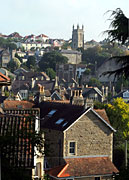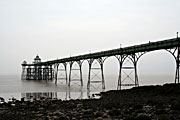 The town of Clevedon is situated on the Bristol Channel Coast and was originally a hillside settlement. The moorland in and around Clevedon was densely occupied during the Roman occupation of Britain and various artefacts have been found in the area. In the Domesday Book, Clevedon is recorded as land held by Mathew of Mortaigne from the King. Mathew let out the land to Hidelbert on Knight’s Fee. This meant that Mathew could count Hidelbert as one of the group of men at arms and knights, which Mathew was bound to maintain for service to the King when necessary.
The town of Clevedon is situated on the Bristol Channel Coast and was originally a hillside settlement. The moorland in and around Clevedon was densely occupied during the Roman occupation of Britain and various artefacts have been found in the area. In the Domesday Book, Clevedon is recorded as land held by Mathew of Mortaigne from the King. Mathew let out the land to Hidelbert on Knight’s Fee. This meant that Mathew could count Hidelbert as one of the group of men at arms and knights, which Mathew was bound to maintain for service to the King when necessary.
The manor of Clevedon was purchased in 1710, by Abraham Elton. Clevedon Court, the residence of the Elton family was built during the reign of Edward II. Although it was altered in the reign of Elizabeth, much of the 14th century work remains. There is a mediaeval hall, mullioned windows and a hanging chapel. The present baronet has developed a pottery known as the Elton Ware, which operates from the adjacent outhouses. Clevedon Court is now a national Trust property and open to visitors.
By the beginning of the 19th century, Clevedon was only the manor house, a few farms and several cottages. Most of these were built on the road from Clevedon Court to the old church of St Andrew. This old church is of ancient date, and stands to the west of the village on Clevedon Point, close to the edge of a steep cliff.
During the early decades of the 19th century, the town began to grow and the need for another church was felt. Lady Elton laid the foundation stone of Christ Church in 1838, and the church was consecrated a year later. It is built in the early English style, and forms a landmark that can be seen for miles. In the first 50 years on the 19th century, the population of Clevedon increased six fold.
 Before long the town became a very popular Victorian seaside resort and there are many fine examples of architecture from that era. As it has grown, the town has established several claims to fame. The first large scale production of Penicillin took place here, as did the development of the first float carburettor.
Before long the town became a very popular Victorian seaside resort and there are many fine examples of architecture from that era. As it has grown, the town has established several claims to fame. The first large scale production of Penicillin took place here, as did the development of the first float carburettor.
Today Clevedon is a lovely town with an attractive coastline on one side and rolling hills on the other. The seafront boasts a restored and operational Grade II listed pier, dating from 1869 and believed to be one of the finest in the country. This was the first pier to be built using mathematical principles, offering a strong but elegant structure to withstand the 40 feet high tide, the second highest in the world. There are great views of the Welsh coast from the pavilion at the end of the pier.
Much of the shore here is pebbled and there are some lovely coastal walks around the town. One of these is named the Poets’ Walk, as many poets and writers are said to have been inspired by the views of the Welsh mountains from the path. These famous names include Coleridge, Tennyson and Thackeray.
There are lots of guest houses and hotels in Clevedon today and the town can be reached easily from the M5 motorway. The nearest mainline railway station is in Yatton, four miles away. There is a wide variety of leisure activities on offer, including various water sports and tennis. The local Jazz Club has a good reputation too. Clevedon offers a wide variety of cafés and restaurants. It has some interesting small shops, in addition to the usual high street chains, and also has a craft centre housed in a 17th century farm building.



